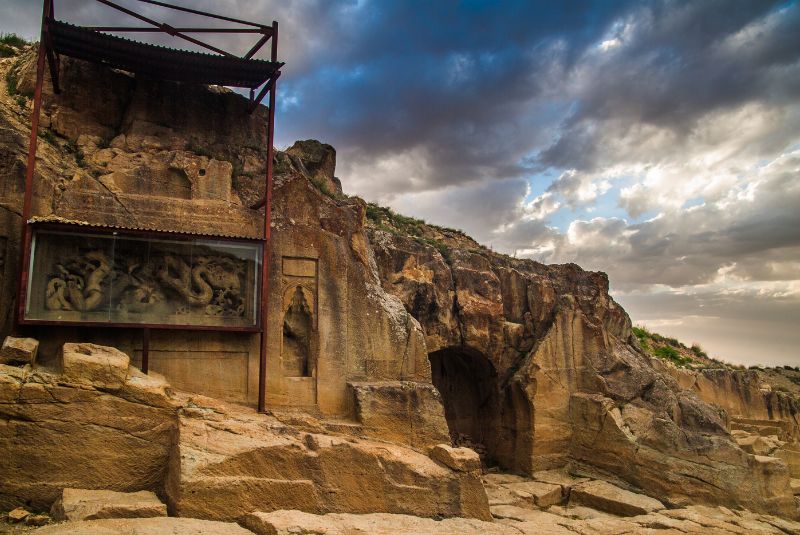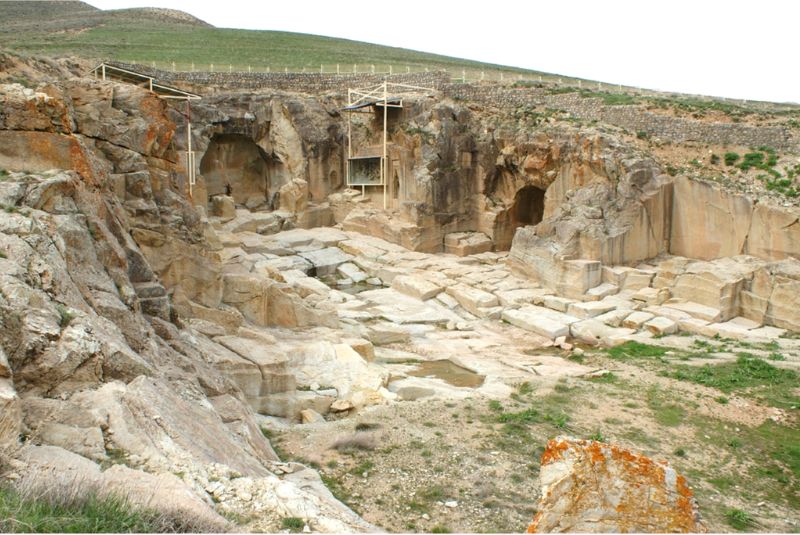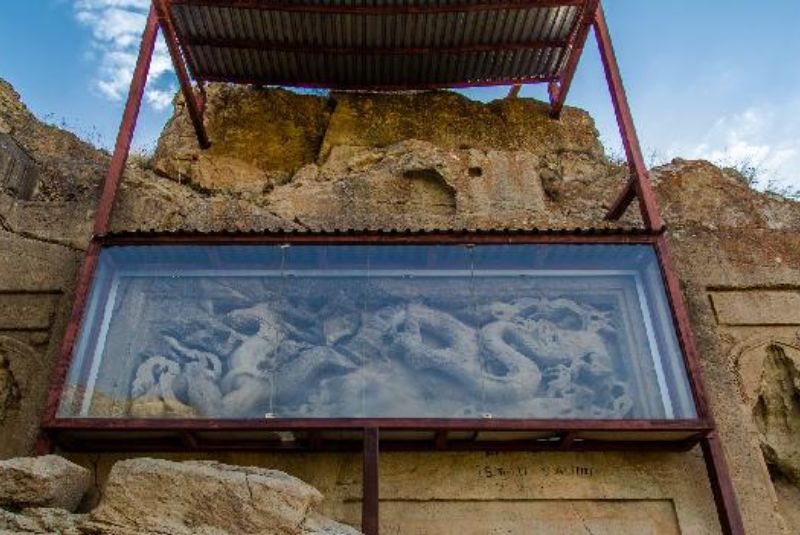Dashkasan Temple: A Dragon Temple in Zanjan, Iran
Since the early years of civilization, temples have long served an important role in not only the fabric of countless religions but also the livelihood of communities.
These magnificent structures offer spiritual solace and showcase architectural marvels that stand as testaments to bygone eras. Whether you seek enlightenment or simply admire architectural wonders, temples are a must-visit on your travel itinerary.
Situated in the illustrious Zanjan province, the historic city of Soltaniyeh boasts a wealth of cultural treasures, including the famed Dashkasan Temple, also known as the Dragon Monument.
The Dashkasan Temple features intricate carvings, including two prominent dragon motifs, showcasing the influence of Far Eastern cultures during the Ilkhanid era.
Registered as one of Iran's national monuments, this temple is a rare gem that captivates visitors with its historical and artistic significance. Read on to learn everything you need to know about the enigmatic Dashkasan Temple.
About Dashkasan Temple

The Dashkasan Temple, also known as the Temple of the Dragon, is a remarkable rock building situated on the outskirts of Vir Village, approximately 15 kilometers southeast of the historic city of Soltaniyeh in Zanjan Province. Dating back to the Ilkhanid period, this stone temple holds significant cultural and historical importance.
The name "Dashkasan" translates to "stonemason" in Azeri, reflecting the craftsmanship involved in its construction. It is alternatively referred to as the Dragon Temple and was officially recognized as one of Iran's national monuments in 1974.
The temple features two prominent dragon motifs, intricately carved on both sides in symmetrical fashion. These reliefs, depicting dragons, are rare in Iranian art and bear the influence of Far Eastern cultures such as Mongolia and China, which had an impact during the Ilkhanid era. Some speculate that the temple existed prior to Islam and that the dragon motifs were added during the Ilkhanid period.
Although the original structure has undergone changes over time, remnants of the temple can still be observed, with large scattered stones found in the temple's corners. Several dragon statues are scattered throughout the temple area, adding to its allure.
Visitors can explore the temple and witness its unique blend of architectural styles and artistic expressions.
| Read more: Fire Temple - The Holy Places Where Zoroastrians Worship God
History of Dashkasan Temple

According to the beliefs of some archaeologists, the origins of this structure date back to before the Islamic era when it served as a place of worship for followers of the Mithraic religion. However, no traces remain from that period.
The current building, on the other hand, belongs to the Ilkhanate period when they ruled Iran approximately 700 years ago. After the death of Arghun Shah, a Mongol ruler, Eljai Khatun, the sister of Sultan Mohammad Khodabandeh, ordered the construction of this building. However, the construction of this structure never reached completion.
The exact reason for this is unclear, but some believe that the order to build this structure was given before the Mongol ruler converted to Islam, and after the Ilkhanids embraced Islam, the construction of this building was halted.
The most significant architectural feature, the prominent dragon reliefs, were created during the Ilkhanid period. In addition to the prominent dragon reliefs, all other decorations in the temple were also created during the Ilkhanid era.
| Discover: Temple of Anahita - A Temple of an Ancient Iranian Goddess
Why is the Temple Decorated with Dragon Motifs?

When you see Dash Kasan for the first time, you might think you've stepped into China because dragons are a well-known symbol in Chinese culture.
The Dashkasan Temple's decoration with dragon motifs may give the impression that it was built by the Chinese. However, in reality, this structure is one of the prominent artifacts of the Ilkhanid period, beautifully carved by the renowned artists of that era amidst the mountains.
In Chinese culture, the dragon is a symbol of power, blessings, and happiness. The kings of the past were also greatly fascinated by power. Perhaps that's why the order to engrave these carvings was issued in the heart of this ancient site.
Legends of Dashkasan Temple
There are numerous legends surrounding this site among the locals of the region. The residents of the village of Vir call the Dashkasan temple "Shirin and Farhad."
In ancient Iranian mythology, Farhad is known as a stone breaker who had a great love for Shirin. That's why this place has gained fame as "Shirin and Farhad."
However, the main reason behind the name Dashkasan for this structure is that it was once a stone mine. When the workers were busy cutting the stones, suddenly beautiful patterns would emerge from the heart of the rocks.
| Also read about: Bisotun - One of the World's Biggest Rock Reliefs
Dashkasan Temple Architecture

The architecture of Dashkasan Temple combines elements of Iranian and Chinese styles in a masterful way. The stone temple is regarded as one of the most prominent examples of rock architecture in Iran.
Its most notable feature, which sets it apart in the country, is the prominent relief carvings of two dragons. These symmetrically created dragon reliefs captivate the attention of enthusiasts of unique architectural styles.
Longitudinal symmetry is one of the fundamental principles emphasized in the construction of the temple and is palpable throughout the entire structure. The dragon reliefs have a length of five meters and a width of 1.5 meters, and the design of the mihrab (prayer niche) with its Islamic and arabesque patterns alongside these two dragons is also eye-catching.
Three arches in the western and eastern parts of the temple have been created within the heart of the rock, adorned with beautiful muqarnas (stalactite) decorations.
Patterns with various designs, one of the main symbols of Iranian art, can also be observed in these arches. It appears that the design and creation of these patterns were influenced by the social conditions in Iran during the 8th century.
Dashkasan Temple is composed of several courtyards and ancient premises, and prominent relief carvings can be found throughout the site. All these features have come together, making Dashkasan a unique masterpiece. Additionally, within the temple complex, three deep and narrow caves are visible, which likely served as dwellings or storage spaces.
It seems that in the construction of this temple, the most advanced stone-cutting technologies with metal tools available at that time were employed. The careful selection of the most suitable location for constructing this temple, among the other areas in the region, indicates the extensive geological knowledge possessed by the builders of this structure.
It is also likely that the stonemasons employed some principles of stonework in their craftsmanship. The temple complex is rectangular, with dimensions ranging from 50 to 100 meters, and a portion of it has been excavated on a hill.
| Suggestion: Naqsh-e Rustam
Dashkasan Temple Location
Dashkasan Temple, which is considered one of the tourist attractions of Sultanieh, is located approximately five kilometers from Vir Village and 15 kilometers northeast of Sultanieh.
The distance between the village and the temple is a smooth dirt road that can be easily traveled by regular vehicles; however, there are no signs along this route, so it is better to seek guidance from local people to reach the temple.
How to Get to the Dashkasan Temple

To reach Dash Kasan Temple, you need to travel to Zanjan province. Take the Zanjan-Abhar Road until you reach Sultanieh. Sultanieh is located 33.5 kilometers southeast of Zanjan. After reaching Sultanieh, take the rural road towards Vir and travel for 11 kilometers until you reach this village. It is advisable to have a local guide with you to avoid any difficulties in finding it.
Attractions near Dashkasan Temple
Soltaniyeh Dome - Largest Brick Dome in the World
Address: Soltaniyeh Square, Allameh Helli Boulevard, Ganjbad Street
Soltaniyeh Dome is one of Iran's registered UNESCO World Heritage sites and is also considered the largest brick dome in the world. This important historical structure, standing at 50 meters in height, is believed to have inspired many architectural works, including the Santa Maria del Fiore Cathedral in Italy and the Taj Mahal. Sultan Mohammad Khodabandeh (El Jaitu), the eighth Ilkhanid king, is credited as the founder of this monument.
Mollahasan Kashani Shrine - A 500 Years old Mausoleum
Address: One kilometer from Soltaniyeh Dome, Soltaniyeh City
Mollahasan Kashani was one of the great figures in Zanjan in the 14th century AD, and his mausoleum was built by the order of Shah Tahmasb I. The interior decorations and architecture of this mausoleum belong to the Qajar period and feature intricate stucco work, plasterwork, and brickwork. The turquoise dome of this structure is considered one of the distinctive features of Iranian architecture.
| Discover: Persepolis - The Great Ancient Persian Capital
Best Time to Visit Dashkasan Temple
The best time to visit Dashkasan Temple is during the spring and summer seasons. In the months of April/May and May/June, the surrounding nature of the temple and Sultanieh Plain reach their most beautiful state.
Late autumn and winter are not suitable for visiting Dash Kasan Temple. The area is very windy and cold during this time, and the road to Vir village is often rough. Nevertheless, winter landscapes have their own special enthusiasts.
Ticket Price and Opening Hours For Dashkasan Temple
Opening hours: 8:00 AM to 6:00 PM
Entrance fee for domestic tourists: 5,000 Tomans
Entrance fee for foreign tourists: 50,000 Tomans
Closed days: Tasua and Ashura (mourning days for Imam Hussein), 21st of Ramadan (martyrdom of Imam Ali), 28th of Safar (passing of the Prophet), 14th of Khordad (passing of Imam Khomeini), 25th of Shawwal (martyrdom of Imam Jafar Sadiq).
Tips for Visiting Dashkasan Temple

- Visit during the spring or summer seasons for the best experience.
- Check the opening hours of Dashkasan Temple (8:00 AM to 6:00 PM).
- Bring local currency (Toman) for the entrance fee (5,000 Toman for domestic tourists, 50,000 Toman for foreign tourists).
- Be aware of religious and cultural holidays that may affect visiting hours or crowd levels.
- Dress comfortably and wear suitable footwear for exploring the temple grounds.
- Consider bringing a hat, sunscreen, and a water bottle, especially during warmer months.
- Respect the religious and cultural significance of the temple and follow any guidelines provided.
- Take time to appreciate the unique architecture and historical importance of Dashkasan Temple.
- Capture beautiful photos but be mindful of any photography restrictions.
- Plan enough time to explore the attractions nearby.
- Check the road conditions to Vir village and be prepared for potential rough patches.
- Research local customs and traditions to ensure a respectful visit.
- Consider hiring a local guide for your Dashkasan temple tours. It will help you have a more in-depth understanding of the temple's history and significance.
Bottom Line
One of the most important historical sites that reflect the culture and art of our ancestors and different religions is the temples. Undoubtedly, one of the most significant stone structures in Iran is the enigmatic Dashkasan Temple.
Its mysterious structure and dragon motifs make it a unique gem. As responsible travelers, let's appreciate and protect these cultural treasures for future generations. Plan your visit to Dashkasan Temple and witness the awe-inspiring beauty of this historical site.
Share your story!
Comment below and let us know about your Experience.
Your story inspires others!


Comment
Leave a Comment